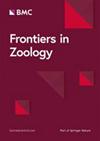Material composition and mechanical properties of the venom-injecting forcipules in centipedes
IF 2.6
2区 生物学
Q1 ZOOLOGY
引用次数: 0
Abstract
Centipedes are terrestrial and predatory arthropods that possess an evolutionary transformed pair of appendages used for venom injection—the forcipules. Many arthropods incorporate reinforcing elements into the cuticle of their piercing or biting structures to enhance hardness, elasticity or resistance to wear and structural failure. Given their frequent exposure to high mechanical stress, we hypothesise that the cuticle of the centipede forcipule might be mechanically reinforced. With a combination of imaging, analytical techniques and mechanical testing, we explore the centipede forcipule in detail to shed light on its morphology and performance. Additionally, we compare these data to characteristics of the locomotory leg to infer evolutionary processes. We examined sclerotization patterns using confocal laser-scanning microscopy based on autofluorescence properties of the cuticle (forcipule and leg) and elemental composition by energy-dispersive X-ray spectroscopy in representative species from all five centipede lineages. These experiments revealed gradually increasing sclerotization towards the forcipular tarsungulum and a stronger sclerotization of joints in taxa with condensed podomeres. Depending on the species, calcium, zinc or chlorine are present with a higher concentration towards the distal tarsungulum. Interestingly, these characteristics are more or less mirrored in the locomotory leg’s pretarsal claw in Epimorpha. To understand how incorporated elements affect mechanical properties, we tested resistance to structural failure, hardness (H) and Young’s modulus (E) in two representative species, one with high zinc and one with high calcium content. Both species, however, exhibit similar properties and no differences in mechanical stress the forcipule can withstand. Our study reveals similarities in the material composition and properties of the forcipules in centipedes. The forcipules transformed from an elongated leg-like appearance into rigid piercing structures. Our data supports their serial homology to the locomotory leg and that the forcipule’s tarsungulum is a fusion of tarsus and pretarsal claw. Calcium or zinc incorporation leads to comparable mechanical properties like in piercing structures of chelicerates and insects, but the elemental incorporation does not increase H and E in centipedes, suggesting that centipedes followed their own pathways in the evolutionary transformation of piercing tools.蜈蚣毒液注射穹窿的材料成分和机械性能
蜈蚣是陆生和掠食性节肢动物,拥有一对用于注射毒液的附肢--蟾蜍甲(forcipules)。许多节肢动物在其穿刺或咬合结构的表皮中加入强化元素,以增强硬度、弹性或抗磨损和结构失效的能力。鉴于蜈蚣经常暴露在高机械应力下,我们推测蜈蚣瓣膜的角质层可能被机械加固了。我们结合成像、分析技术和机械测试,详细研究了蜈蚣穹窿的形态和性能。此外,我们还将这些数据与运动腿的特征进行比较,以推断其进化过程。我们使用激光扫描共聚焦显微镜,根据蜈蚣所有五个品系的角质层(蹄甲和腿)的自发荧光特性和能量色散 X 射线光谱的元素组成,研究了蜈蚣的硬壳化模式。这些实验表明,硬质化程度向趾甲跗节逐渐增加,在荚膜凝聚的类群中,关节的硬质化程度更强。根据物种的不同,钙、锌或氯在跗关节远端含量较高。有趣的是,这些特征或多或少地反映在 Epimorpha 的运动腿前跗爪上。为了了解所含元素如何影响机械性能,我们测试了两个具有代表性的物种的抗结构破坏能力、硬度(H)和杨氏模量(E),一个含锌量高,一个含钙量高。然而,这两个物种都表现出相似的特性,并且在小穹窿所能承受的机械应力方面没有差异。我们的研究揭示了蜈蚣穹窿的材料成分和特性的相似性。穹窿从细长的腿状外观转变为坚硬的穿刺结构。我们的数据支持它们与运动腿的序列同源性,并支持穹窿跗节是跗节和前跗节爪的融合体。钙或锌的加入使蜈蚣具有与螯足类和昆虫的穿刺结构相似的机械特性,但元素的加入并没有增加蜈蚣的H和E,这表明蜈蚣在穿刺工具的进化转变过程中遵循了自己的路径。
本文章由计算机程序翻译,如有差异,请以英文原文为准。
求助全文
约1分钟内获得全文
求助全文
来源期刊

Frontiers in Zoology
ZOOLOGY-
CiteScore
4.90
自引率
0.00%
发文量
29
审稿时长
>12 weeks
期刊介绍:
Frontiers in Zoology is an open access, peer-reviewed online journal publishing high quality research articles and reviews on all aspects of animal life.
As a biological discipline, zoology has one of the longest histories. Today it occasionally appears as though, due to the rapid expansion of life sciences, zoology has been replaced by more or less independent sub-disciplines amongst which exchange is often sparse. However, the recent advance of molecular methodology into "classical" fields of biology, and the development of theories that can explain phenomena on different levels of organisation, has led to a re-integration of zoological disciplines promoting a broader than usual approach to zoological questions. Zoology has re-emerged as an integrative discipline encompassing the most diverse aspects of animal life, from the level of the gene to the level of the ecosystem.
Frontiers in Zoology is the first open access journal focusing on zoology as a whole. It aims to represent and re-unite the various disciplines that look at animal life from different perspectives and at providing the basis for a comprehensive understanding of zoological phenomena on all levels of analysis. Frontiers in Zoology provides a unique opportunity to publish high quality research and reviews on zoological issues that will be internationally accessible to any reader at no cost.
The journal was initiated and is supported by the Deutsche Zoologische Gesellschaft, one of the largest national zoological societies with more than a century-long tradition in promoting high-level zoological research.
 求助内容:
求助内容: 应助结果提醒方式:
应助结果提醒方式:


